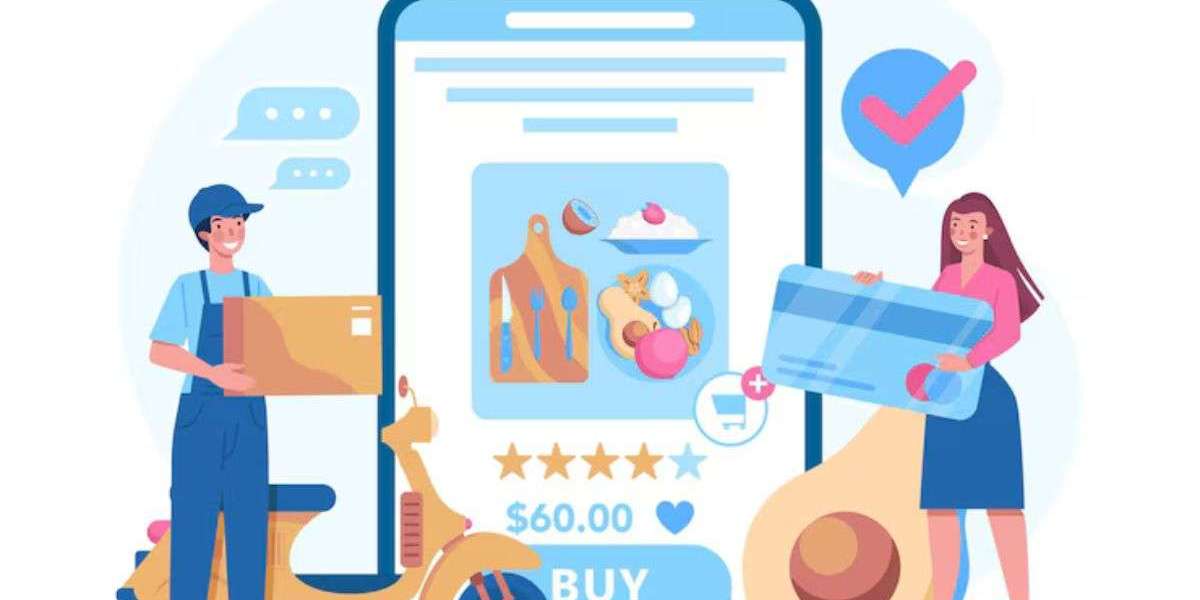Grocery shopping is something that all of us have to do on a regular basis to stock our kitchens and feed our families. However, with busy modern lifestyles, finding time for a shopping trip to the supermarket is not always easy or convenient. More and more, people are leading hectic lives with packed schedules. Spending an hour navigating crowded aisles and waiting in long checkout lines is a chore that many would prefer to avoid.
At the same time, grocery retailers are facing increased competition and pressure on profits. Maintaining large expensive retail footprints and checkout-centered operations comes with substantial costs. To remain viable in this landscape, grocers need innovative strategies to deepen customer loyalty while also improving efficiencies.
This is where on-demand grocery delivery services like UberEats present an intriguing opportunity. By allowing customers to shop from home on their schedule and have orders delivered right to their doorsteps, such applications address major pain points. They also open the door for retailers to enhance revenues and reduce expenses. In many ways, developing an UberEats counterpart for groceries represents a smart business move with benefits for all involved parties.
Convenience for Customers
First and foremost, digital grocery shopping services solve the inconvenient hassle of physically visiting stores. People lead busy lives with responsibilities that make setting aside time for errands difficult. Sending groceries to a customer's location on their timeframe provides a big convenience factor.
No more rushing to a supermarket after work or on weekends to squeeze in shopping before they close. No more dragging little kids around stores in the evening while juggling tasks. Online ordering empowers people to purchase staples without disrupting precious free time or struggling with crowds. The ability to shop 24/7 from any device is hugely appealing and solves a major irritation.
Reduced Impulse Purchases
In addition to saving time, ordering groceries online can help customers reduce impulse and unplanned spending. The cluttered aisles and festive displays in physical stores are carefully designed to catch the eye and tempt unneeded purchases. But shopping remotely removes these in-person marketing influences.
Customers can browse products at their leisure without the distractions of other shoppers, enticing sales, or candy displays by the register. This gives them a chance to realistically compare prices, check ingredients and nutrition labels, and only add items that fill actual needs rather than just catching their fancy in the moment. The result is trimmer, more purposeful baskets focused only on planned meals rather than whatever looks good on the shelf.
Wider Product Selection
Conventional supermarkets necessarily limit the variety carried in each category to fit everything on the shelving space available. But moving shopping online enables grocers to offer their full inventory to each customer regardless of physical store size constraints.
Digital shelves have infinite capacity so every product a retailer stocks can be browseable and orderable from any location. This includes specialty or niche items that may only appeal to certain demographics. It also facilitates one-stop-shopping by giving access to the breadth of a retailer's assortment rather than a localized subset. The expanded selection strengthens customer loyalty through fulfillment of more needs and preferences. Visit: https://zipprr.com/ubereats-clone/
Improved Accessibility
Doorstep delivery opens grocery shopping up to demographics previously unable to regularly visit physical stores. This includes people with limited mobility due to illness, disability, or advanced age for whom even a short trip requires significant effort.
Those relying on public transportation in areas lacking convenient transit routes have new independence. Families caring for young children or dealing with special needs can order without the stress of hauling little ones through stores. Busy professionals juggling work commitments gain flexibility.
Even customers with transportation but lacking time benefit from reduced errand running. Overall, online options level the playing field and strengthen food access equity for all community members regardless of individual challenges or circumstances. This stimulates greater retail engagement and spending from an expanded customer population.
Enhanced Customer Loyalty
Convenience breeds loyalty, and satisfying major customer pain points through innovative solutions is sure to foster stronger emotional bonds and preference for supporting brands. Retailers offering delivery gain a substantial competitive differentiator that builds repeat patronage.
Satisfied shoppers who come to rely on the effortless services are less likely to stray to alternatives even if solely for minor price or product variances. They voluntarily promote the brand through positive word-of-mouth, helping acquire new users as well. Data shows most loyal delivery app customers increase overall basket sizes and order frequencies over time as familiarity grows.
Targeting millennial and generation Z demographics especially accustomed to on-demand economy services also engages future consumer bases which will remain reliant on such conveniences. Strategically innovating strengthens customer lifetime value for years ahead as preferences cement.
Increased Revenue Opportunity
While in-store, some high-margin products like prepared meals, meal kits, or assembled recipe components cannot be feasibly displayed or sold due to space, equipment, or freshness restrictions. But through online ordering, these sorts of add-on items become viable revenue streams.
Grocers gain the ability to feature value-added specialty products, subscriptions, or short-production-run seasonal offerings. Digital storefronts open new categories like alcohol which necessitate licensing hurdles in physical locations. Pop-up shops, targeted promotions, and custom bundles can also boost average order values and spending.
In addition, strategic partnerships could integrate meal delivery, restaurant take-out, or other food businesses to create a one-stop online food marketplace. There are abundant methods to upsell complementary products and drive incremental high-profit sales through frictionless carts without real estate constraints.
New Customer Acquisition
When shopping online, customers get exposed to a much broader assortment than what catches their eye aisles. They have time to peruse selections without the mental clutter of a busy store environment. This presents branding and discovery opportunities to attract new patrons who may not routinely shop a particular supermarket in person otherwise.
Targeted digital promotions, informative product pages, and simplified reordering increase chances impulse add-ons become routine staples. Sample subscriptions or limited time promotions encourage trialling new items. Browsing drives serendipitous finds which can shift future brand loyalties.
It also opens geographical territories beyond physical store footprints. Delivery radius expansion strategically targets desirable adjacent areas, capturing market shares previously inaccessible. Overall, online channels serve an acquisition engine alongside the loyalty benefits for established customers.
Operational Efficiencies
Compared to traditional in-store checkout processes, online ordering streamlines operations and trims expensive overhead. Delivery fulfillment centralized in warehouses, shared kitchens, or dark stores requires significantly less commercial real estate than vast retail spaces.
There is no need for parking lots, checkouts, customer service desks, or staffing for peak volume periods. Digital interfaces allow self-checkout and automatic order sorting to maximize labor productivity. Real-time order visibility gives flexibility to intelligently route deliveries for optimal efficiency and minimal wasted mileage.
Inventory management also benefits from analytics identifying demand patterns to perfectly tune assortments with less waste. Online purchase records likewise provide detailed sales insights unattainable on the retail floor. The trove of customer behavior data aids everything from procurement to marketing and new business ventures.
Data Collection Advantages
Speaking of data, online ordering presents a goldmine of first-party shopping behavior and demographic information. Detailed purchase histories, browsing and search patterns, location data, engagement metrics, and more provide unparalleled intelligence about customers’ true preferences.
Aggregate analyses reveal category and brand affinities alongside opportunities. This understanding helps retailers profoundly refine store layouts, product mix, pricing, merchandising, specials, and assortment strategies store-by-store based on neighborhood demographics for maximum sales.
Customer profiles aid one-to-one marketing, predictive replenishment, and targeted win-back promotions. Continually collecting vast troves of shopping records online is priceless for optimizing every business function. Physical retailers cannot hope to compete on this front without investing heavily in transitioning sales channels.
Lower Real Estate Costs
Perhaps most significantly, substituting a portion of in-store sales through online fulfillment substantially reduces pricey real estate investment needs over time. Commercial property, utilities, repairs and maintenance represent massive fixed costs which sap retailer profitability and ability to expand.
Each warehouse, prep kitchen, or distribution micro-fulfillment center required to support digital and delivery orders encompasses a small fraction of the square footage of even a single large supermarket. With greater volumes, multiple stores’ inventories can potentially consolidate into centralized facilities.
This property diversification yields significant savings while also making previously cost-prohibitive locations viable. Returns become less reliant on high-volume physical storefronts in specific trade areas with unpredictable real estate cycles. Success depends less on securing advantageous leases. Overall financial risks diminish dramatically by cutting real estate reliance.
Potential for Profitability
As grocery delivery services scale to fulfill a larger percentage of retailer sales, several economics kick in that can potentially make delivery more profitable than traditional in-store models.
Leveraging a centralized dark store or warehouse-based distribution means fulfillment costs decline on a per-order basis as volumes increase. Unlike retail locations needing to staff for peak hours, digital operations benefit from predictive demand patterns and can optimize resourcing.
Online shopping facilitates automated order sorting and packing using specialized workflow equipment, improving productivity over manual tasks. This translates to lower labor expenses per delivery. Streamlined electronic interfaces also reduce typical checkout costs.
Eliminating square-footage overhead from physical retail spaces is perhaps the biggest potential money-saver. While delivery does introduce vehicle and infrastructure investments, these pale compared to property taxes, utilities, and personnel required for massive supermarket footprints.
As analytics identify customer preferences, tailored assortments minimize food waste from over-ordering certain items. Digital interfaces also empower promotions targeting specific purchasers based on past buying patterns for maximum revenue per promotion.
Finally, data-mining of online order histories gives unprecedented customer understanding to refine all operation facets from procurement to predictive inventory management for further leveraging cost-efficiencies. The margins may potentially exceed conventional in-store sales over the long-run at sufficient scale.
Conclusion
In conclusion, developing an online grocery ordering and delivery platform modeled after popular on-demand apps offers clear advantages that will drive customer satisfaction, retention and spending. It also promises new efficiencies and cost savings able to strengthen long term financial sustainability in the competitive grocery industry. For these reasons, exploring this innovation is a smart strategic move for grocers.








